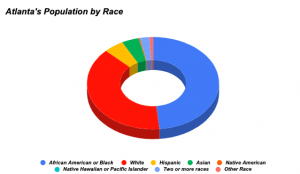“Energy Equity” is the fair distribution of the benefits and burdens of our energy production and consumption.
Many communities, usually low-income, elderly, and communities of color, do not know how energy decisions are made until it is too late. So they continue to pay nuclear plants for utility bills. These communities are not able to afford to install solar panels or energy efficiency updates in their home. So these communities continue to live near the 50-year-old coal-fired plant next door continues to spew air and water pollution. These low-income households do not partake in energy efficiency, solar, and electric vehicle programs but how these programs are financed is raising the electric price for all customers (Marilyn A Brown et al., 2020). Then it is showcased that the energy burden is higher in low-income areas and that they also spend a quarter of their income on energy. This is similar to Aygeman(2013) stating, “Famine usually happens in the presence of plenty but the absence of democracy”. This comparison meaning that surrounding these communities is a surplus of energy initiatives that they cannot gain access to, so they’re essentially starving.
This is how the inequity is shown in many’s push towards renewable energy. “Chandra Farley, with the Partnership for Southern Equity, states that black households in Atlanta struggle keep the lights on and pay 10% of their income to electricity bills wants policymakers to help Atlanta’s low-income communities by investing in the green plan… it’s really a matter of priorities” (Farley, 2020). The priorities of Atlanta must refocus to ensure that equity is being placed in all programs that are being implemented with a focus on having 100% renewable energy by 2035.
Types of Energy Equity
Procedural equity – “The idea of fairness and transparency of the processes that allocate resources and resolve disputes. Connected to the desire for due, one aspect of procedural equity relates to an administrative and legal proceeding. Inclusive and authentic engagement in the process to develop, implement, and adjudicate programs or policies is key to procedural equity. Economically disadvantaged communities across the country are amplifying their voices to ensure that the clean energy transition considers their needs” (Marilyn A Brown et al., 2020).
Distributive equity – “Fairness in the allocation of rights or resources, arguing that one’s place of birth, social status, and family influences are matters of luck that should not unduly influence the benefits we receive in life (Rawls 1971)… Extended by many to argue that distributive equity is achieved when programs and policies result in fair distributions of benefits and burdens across all segments of a community and prioritizing those with the greatest need” (Marilyn A Brown et al., 2020).
Intergenerational equity – “Adds a time dimension to the equity discussion by considering community obligations to future generations. Actions that serve to increase rather than limit the development options of future generations can be said to improve intergenerational equity (Norton 2005)… Intergenerational equity frequently involves deliberating which aspects of the present should be maintained or changed for future generations (Williams-Rajee 2015). How these programs may impact the social and economic contours of communities across generations has received much less emphasis” (Marilyn A Brown et al., 2020).

To successfully have energy equity within the city of Atlanta these different types of energy equity all must be able to be achieved. There are a variety of different aspects that must be met to truly have met be able to acknowledge these communities that have been continually disenfranchised and oppressed throughout for centuries.
Who has a Seat at the Energy Equity Table?
 Atlanta is a majority-minority city, some even go as far as nicknaming it the “Black Mecca”. This goes into understanding if this is reflected in who makes the decisions about energy in Atlanta. When interviewing an environmental justice activist in the city of Atlanta she discussed, “The Public Service Commission of Georgia makes all the state’s decisions about our utilities so the Internet and electricity. These are 5 elected officials that have been historically white men” (Personal Interview, 03/27). From this statement alone it is seen that racial minorities are underrepresented in utility decision-making. Although African Americans make up a majority of Atlanta’s population. This is why activists working towards environmental justice have understood for decades that waiting for the government to act on these issues, such as energy equity jeopardizes the overall wellbeing of communities of color (Maharawal & Nastasia, 2012). Not being equitably represented in government confirms to many, communities, that issues they face will not be alleviated.
Atlanta is a majority-minority city, some even go as far as nicknaming it the “Black Mecca”. This goes into understanding if this is reflected in who makes the decisions about energy in Atlanta. When interviewing an environmental justice activist in the city of Atlanta she discussed, “The Public Service Commission of Georgia makes all the state’s decisions about our utilities so the Internet and electricity. These are 5 elected officials that have been historically white men” (Personal Interview, 03/27). From this statement alone it is seen that racial minorities are underrepresented in utility decision-making. Although African Americans make up a majority of Atlanta’s population. This is why activists working towards environmental justice have understood for decades that waiting for the government to act on these issues, such as energy equity jeopardizes the overall wellbeing of communities of color (Maharawal & Nastasia, 2012). Not being equitably represented in government confirms to many, communities, that issues they face will not be alleviated.

“Only 4.4% of 21 board members at rural electric cooperatives in the South are African Americans. Even more bleakly, Hispanics make up just 0.3% of board members or individuals in governing positions on the boards of rural electric cooperatives in the South.22 On elected public service commissions in the south, only one in six commissioners are people of color, and the commissions for Georgia, Alabama, and Mississippi are all-white” (Just Energy Summit, 4).
Path to Energy Equity in Atlanta
Through the interview conducted three organizations were discussed that are doing amazing work in Atlanta, Georgia:

Partnership for Southern Equity’s (PSE) main focus is to address inequities in communities to be able to create prosperity that can be shared by all and not just a few. PSE has a four-pronged approach to continuing the work on energy equity. They focus on coalition building through their Just Energy Circle. Which assembles experts, advocates, and community members to work together to envision policies for equitable energy. They also emphasize community organization and engagement through creating these community-led coalitions to mobilize the advocacy from the first-person accounts. Communities affected by the inequities of energy policies are given long-term engagement by PSE where they effectively use those relationships to help voters turn out to positively affect the community. Leadership engagement through PSE’s created Just Energy Academy that focuses on “the next generation of equity leaders who aspire to be energy equity and climate justice leaders in their communities” (PSE, n.d.). https://psequity.org/
Metro Atlanta Youth Energy Corps (MAYE Corps) is a Metro Atlanta-based, a youth-led team committed to implementing energy equity programs that center youth leadership, racial and social justice, and local collaboration. https://mayecorps.weebly.com/

Drawdown Georgia is the first state-centered effort to crowd solve for climate change, with 20 high-impact solutions that are tailored to Georgia’s unique natural, economic, and social resources. These solutions can help Georgia keep multiple megatons of carbon out of the atmosphere. https://www.drawdownga.org/
The majority of these initiatives focus on “bottom-up” organizing. Which has always had to be a staple in environmental justice work. Bottom-up organizing is ” organizing at the center of its strategies — mostly because few outsiders of these communities, who aren’t suffering from asthma and high cancer rates, will fight against their root causes ( Maharawal & Nastasia, 2012). This organizing of placing the power back in the hands of those most affected allows for the issues that energy inequity is causing to be addressed.

Just Energy Equity
When completely achieved in Atlanta, energy equity will meet the conditions of just sustainability that Aygeman (2013) puts forth. Improving the quality of life and well-being as the first condition will be achieved through energy equity. Everyone must have the ability to flourish and through energy equity providing equitable and just access to renewable energy will help everyone, including communities of color and low-income ones as well. The second condition, meeting the needs of both present and future generations, is beginning to be met through the understanding of energy equity and how it must be achieved to have a future where everyone feels seen in environmental justice. The third condition is met as energy equity is ensuring that all communities that have been historically oppressed are given equitable access to clean energy. The fourth condition of understanding and living within the limits of the ecosystem must be more emphasized through energy equity. This condition can be met, but energy equity, as it stands now, is focusing on access to all. Although as a counterargument with energy equity being a fight for clean and renewable energy for all it is incorporated as an understanding of the limits of the ecosystem.
Conclusion
Researching energy equity created an understanding that the city of Atlanta does not actually push forward equity when it comes to climate change. It is independent initiatives that is fighting for equity within the city of Atlanta. If it was not for these initiatives to understand and see the race and class disparities in climate change these issues would never get resolved. Implications from our study showcase that Atlanta, although a majority-minority community, does not have the representation that it must have to resolve these issues. This was showcased in many articles read as well as the interview with environmental justice activist in the city of Atlanta. She discusses this and states how although there is a significant percentage of Black individuals in Atlanta they are not added to the climate change conversation as they should be. Future research should focus on how Atlanta’s government can support these initiatives more and what kind of support these initiatives need.
